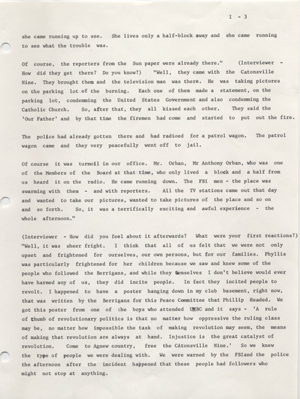 |
Burning of draft board records by Philip and Daniel Berrigan and others, May 17, 1968: an interview with Mary E. Murphy given on November 2, 1972
 |
5 / 15 |
 |



| Collection: |
Friends of Catonsville Library |
| Date: |
1972-11-02 |
| Date of Digitization: |
2004-03-29 |
| Source: |
Catonsville Library |
| Original Dimensions: |
28 x 22 cm |
| Creator: |
Murphy, Mary E. |
|
|
Notes:
This a transcript of a recorded interview with Mrs. Mary E. Murphy who was the Chief Clerk at the Draft Board office no. 33 at the time of the event of the forceful removing and burning of the draft cards by the Catonsville Nine group.
Transcription: she came running up to see. She lives only a half-block away and she came running
to see what the trouble was.
Of course, the reporters from the Sun paper were already there." (Interviewer-
How did they get there? Do you know?) "Well,they came with the Catonsville
Nine. They brought them and the television man was there. He was taking pictures
on the parking lot of the burning. Each one of them made a statement, on the
parking lot, condemming the United States Government and also condemming the
Catholic Church. So, after that, they all kissed each other. They said the
'Our Father' and by that time the firemen had come and started to put out the fire.
The police had already gotten there and had radioed for a patrol wagon. The patrol
wagon came and they very peacefully went off to jail.
Of course it was turmoil in our office. Mr. Orban, Mr Anthony Orban, who was one
of the Members of the Board at that time, who only lived a block and a half from
us heard it on the radio. He came running down. The FBI men - the place was
swarming with them - and with reporters. All the TV stations came out that day
and wanted to take our pictures, wanted to take pictures of the place and so on
and so forth. So, it was a terrifically exciting and awful experience - the
whole afternoon."
(Interviewer - How did you feel about it afterwards? What were your first reactions?)
"Well, it was sheer fright. I think that all of us felt that we were not only
upset and frightened for ourselves, our own persons, but for our families. Phyllis
was particularly frightened for her children because we saw and knew some of the
people who followed the Berrigans, and while they themselves I don't believe would ever
have harmed any of us, they did incite people. In fact they incited people to
revolt. I happened to have a poster hanging down in my club basement, right now,
that was written by the Berrigans for this Peace Committee that Phillip Headed. We
got this poster from one of the boys who attended UMBC and it says - 'A rule
of thumb of revolutionary politics is that no matter how oppressive the ruling class
may be, no matter how impossible the task of making revolution may seem, the means
of making that revolution are always at hand. Injustice is the great catalyst of
revolution. Come to Agnew country, free the Catonsville Nine.' So we knew
the type of people we were dealing with. We were warned by the FBI and the police
the afternoon after the incident happened that these people had followers who
might not stop at anything.
|




